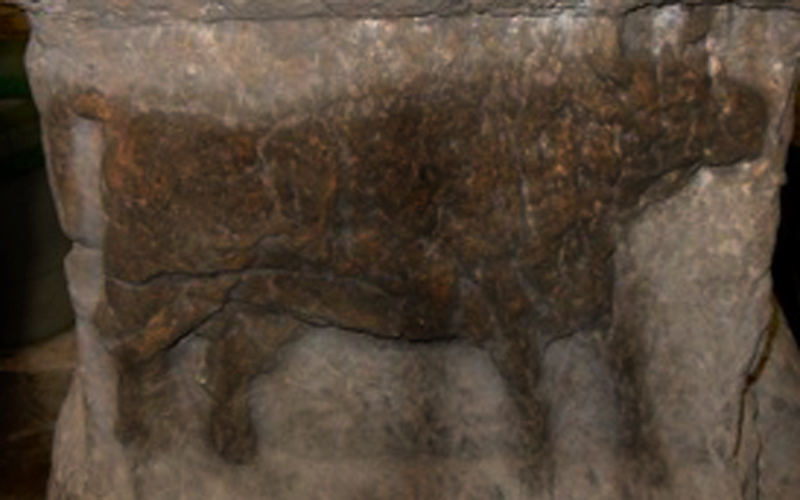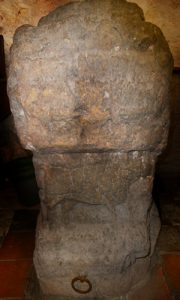For many years this much damaged stone altar in St Mary’s Church, Stone in Oxney, has routinely been thought to be associated with the Roman religion of Mithras, often called the god of the Roman legions, whose temples were mainly built underground. In one leaflet the metal ring attached to one side is described as having been used to secure sacrificial victims, even though there is no evidence that the followers of Mithras ever engaged in this practice. Only one of the images on the four side panels of the altar is complete, that of a standing bull. The others sides show fragments of what might be bulls.
In Mithraic iconography if a bull appears on an altar it is generally being sacrificed by the god; just Google ‘tauroctony’. About 3ft 8in (114 cm) in height, with a base of about 2ft by 1ft 10in, the altar is said to be made of Kentish ragstone, leading to speculation that it may have come from the Hythe area of Kent, a few miles to the east of Stone, possibly from the ruins of the fort at Portus Lemanis, today known as Stutfall Castle.
There is little record of Roman activity around Stone. A few tiles described as being Roman were found when a well was dug at the vicarage in the late 1880s and this information may have been the basis of Malcolm Saville’s 1964 children’s book Treasure at Amorys, in which the famous Lone Piners find a Mithraic temple near an old house at Stone, entered by descending into a well.
Other references suggest the altar may have been found under the floor of the north chapel at some time before 1815 and local legend speaks of tunnels in the mound on which the church is built. There has been speculation about the name of the village.
Once Christianity had hitched its wagon to the Roman state, it suppressed the worship of Mithras, sometimes violently, and often built a church above an abandoned subterranean Mithraic temple – I suggest Googling ‘Basilica di San Clemente al Laterano’, near the Coliseum in Rome, for an amazing example of this. Many visitors to it have commented on the haunting, even troubling, atmosphere at the Mithraic level, and some quickly leave it.
In some ways the Roman religion of Mithras was too close to Christianity for the latter’s comfort. Mithras is frequently shown within the circle of the signs of the zodiac, even spinning it. These signs are on the font in Brookland church.
It is likely that the altar at Stone is of Roman origin, but is it Mithraic? It does not have the usual appearance of such an altar and Mithraic temples are usually found where there were military garrisons, like those on Hadrian’s Wall, at large population centres, like the one in the City of London (now in storage, awaiting relocation to its original site) and at major ports. It is time, I think, to let geophysics settle whether there is a Mithraic temple beneath Stone parish church.




